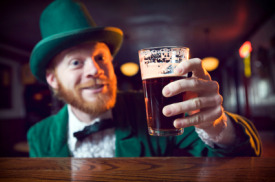
Irish Red Ales are similar enough to Scottish ales that the BJCP has included them in the same style category. No one really knows why Irish ales were originally red, but it probably has something to do with the different ways that grains are malted and kilned between Ireland and the rest of England and Scotland. Today, Irish red ales get their red color from the use of a small amount of highly kilned grain such as roasted barley. The beer is a lighter, maltier and less hoppy Irish version of an English bitter style. The signature characteristics of this red ale is its toasty notes and dry finish possibly with some diacetyl and caramel sweetness. In Ultimate Beer, Michael Jackson says of Irish ales, “…there is also in Irish ales a sweetness, a creaminess, and sometimes a slight butteriness…”
The Irish have had slightly better luck at growing hops than the Scottish farmers, so maybe this affects the amount paid for hop imports. The GABF style listing for Irish Red describes the beer as having a medium hop bitterness and flavor most often with no hop aroma. When present,it looks like the hop flavor is from English varieties and is usually low.
There doesn’t seem to be much history for this beer online. It is possible that it was simply taken for granted as the local session beer. Stouts are much more popular in Ireland and make up a huge part of the market there. Most ales produced in Ireland today are of the Irish red style. If you look at most top ten lists, there are far more American versions than those from Ireland. There are even a few that are somewhat mis-labeled as ales when it is evident that they are lagers and not to style.
The best descriptor for an Irish red ale is that it’s a balanced beer. Important factors in brewing one is to keep the darker malts (roasted flavors), caramel malts (sweet flavors), and hop flavors and bitterness, in check and in balance. Over-use of any of these ingredients can throw the beer out of balance and out of style. English pale ale malts are often used which will give the nice toasty notes the beer is known for, but it’s easy to cover these flavors up when the beer is out of balance. Many Irish Reds are brewed as lagers but with proper temperature control and cooler fermentation temps, you can brew a clean beer with low esters using ale yeast. Be careful not to get the ale yeast too cold that the beer does not attenuate enough and leaves the ale too sweet. A small amount of diacetyl is acceptable, but it’s probably better to keep this to a minimum. Acceptable does not always mean preferred.
Irish Red Ale Description
- Aroma: An Irish red ale has low to medium malt aroma, usually with caramel notes but occasionally toasty or toffee-like in nature. Many versions have a light buttery character (although this is not required). Hop aroma is usually not present but can be low in some beers. You should not notice much in the way of esters as this is typically a very clean beer.
- Appearance: The color can run from amber to the more popular deep reddish copper color. Clarity is usually very good but some chill haze is acceptable at low temperatures. There should be a low off-white to tan colored head.
- Flavor: Most beers in this style will exhibit a moderate caramel malt flavor and sweetness, occasionally with a buttered toast or toffee-like quality. Irish reds will usually finish with a light taste of roasted grain, which lends a characteristic dryness to the finish. Some examples may have a light English hop flavor but generally you will find that there is none present in most examples. Hop bitterness is medium-low but the roasted grains used can accentuate this bitterness into the medium range. Medium-dry to dry finish which can be accentuated by the highly kilned malt. Clean and smooth (lager versions can be very smooth). No esters should be present.
- Mouthfeel: Irish red ales will have a medium-light to medium body, although examples containing low levels of diacetyl may have a slightly slick mouthfeel. Moderate carbonation in the 2 to 2.5 volume range. Smooth, moderately attenuated (more so than Scottish ales) often with a slight alcohol warmth in stronger versions.
- Overall Impression: Irish Reds are very drinkable beers that are malt-focused with an initial sweetness, toasty notes, and a roasted dryness in the finish.
- Comments: These beers are sometimes brewed as a lager (if so, generally will not exhibit a diacetyl character). When served too cold, the roasted character and bitterness may seem more elevated.
- Ingredients: The beer may contain some adjuncts (corn, rice, or sugar), although excessive adjunct use will harm the character of the beer. Generally has a bit of roasted barley to provide reddish color and dry roasted finish. UK/Irish malts, hops, yeast.
- Vital Statistics: OG: 1.044 – 1.060 FG: 1.010 – 1.014 IBUs: 17 – 28 SRM: 9 – 18 ABV: 4.0 – 6.0%.
- Commercial Examples: Three Floyds Brian Boru Old Irish Ale, Great Lakes Conway’s Irish Ale (a bit strong at 6.5%), Kilkenny Irish Beer, O’Hara’s Irish Red Ale, Smithwick’s (pronounced smid-icks) Irish Ale, Beamish Red Ale, Caffrey’s Irish Ale, Goose Island Kilgubbin Red Ale, Murphy’s Irish Red (lager), Boulevard Irish Ale, Harpoon Hibernian Ale.
References: Information for this page was adapted from the 2008 BJCP Style Guidelines, Brewing Classic Styles, 80 Winning Recipes Anyone Can Brew, by Jamil Zainasheff and John J. Palmer, and Ultimate Beer by Michael Jackson.
To Purchase MoreBeer.com’s Irish Red Ale Kit, Click Here
Go From Irish Red Ale Back to Scottish Ales
